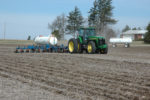Advertise Follow Us
No-Till Farmer News
Purdue Ag Economy Barometer Finds That Most Growers Still New to Using Cover Crops
Out of 400 large-acreage growers surveyed, 41% are currently seeding covers on their operations.
Read More
No-Till Farmer Influencers & Innovators
[Podcast] Why No-Till Benefits Birds with Kelly VanBeek
In this episode of the No-Till Farmer Influencers & Innovators podcast, brought to you by Terrasym, Frank Lessiter gets into the weeds with Kelly VanBeek, wildlife biologist with the U.S. Fish and Wildlife Service’s Migratory Bird Program to discuss which no-till fields provide the best habitats for songbirds, what cover crops are most hospitable to birds and finding a balance between productivity and conservation on farmland.
Read More







